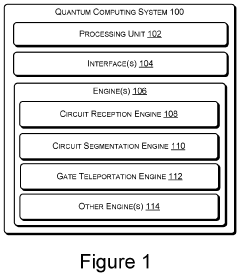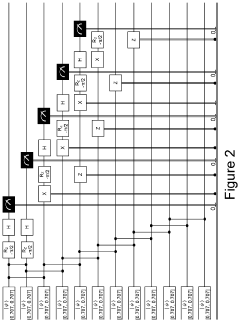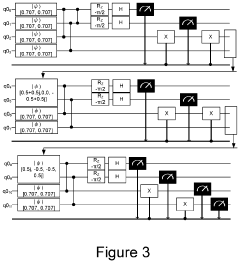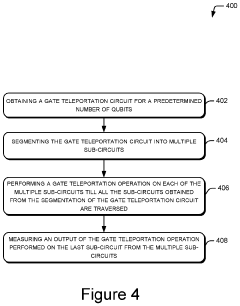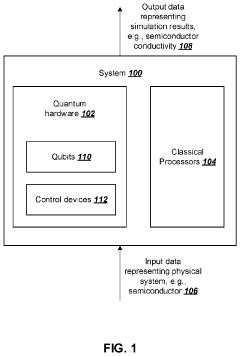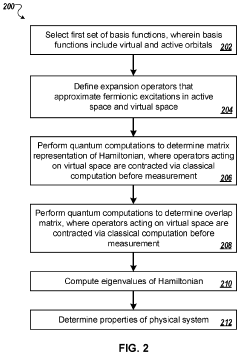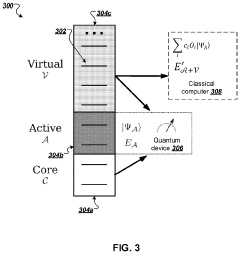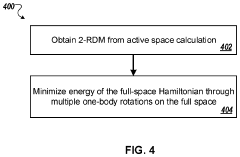Quantum Computing Techniques in Atmospheric Sciences
JUL 17, 20259 MIN READ
Generate Your Research Report Instantly with AI Agent
Patsnap Eureka helps you evaluate technical feasibility & market potential.
Quantum Atmospheric Modeling: Background and Objectives
Quantum computing has emerged as a revolutionary technology with the potential to transform various scientific fields, including atmospheric sciences. The integration of quantum computing techniques into atmospheric modeling represents a significant leap forward in our ability to understand and predict complex weather patterns and climate phenomena.
The development of quantum atmospheric modeling is driven by the increasing need for more accurate and efficient simulations of Earth's atmosphere. Traditional computational methods have reached their limits in handling the vast amounts of data and complex calculations required for high-resolution atmospheric models. Quantum computing offers a promising solution to overcome these limitations, leveraging the principles of quantum mechanics to perform computations that are infeasible for classical computers.
The primary objective of quantum atmospheric modeling is to harness the power of quantum algorithms and hardware to enhance the accuracy, speed, and scale of atmospheric simulations. This includes improving weather forecasting, climate projections, and our understanding of atmospheric processes at both local and global scales. By utilizing quantum superposition and entanglement, researchers aim to model intricate atmospheric dynamics with unprecedented precision and efficiency.
One of the key goals in this field is to develop quantum algorithms specifically tailored for atmospheric science applications. These algorithms must be capable of handling the non-linear equations and chaotic systems that characterize atmospheric dynamics. Quantum-inspired optimization techniques and quantum machine learning approaches are being explored to tackle these challenges, with the potential to revolutionize how we process and analyze atmospheric data.
Another critical objective is to address the scalability issues inherent in classical atmospheric models. Quantum computing's ability to perform parallel computations on a massive scale could enable the simulation of atmospheric processes at much higher resolutions and over longer time scales than currently possible. This increased computational power could lead to more accurate long-term climate predictions and improved understanding of climate change impacts.
The integration of quantum computing with existing atmospheric modeling infrastructure is also a significant focus. Researchers are working on hybrid classical-quantum approaches that combine the strengths of both computing paradigms. This hybrid approach aims to leverage quantum advantages in specific computational bottlenecks while maintaining the reliability and extensive knowledge base of classical atmospheric models.
As quantum atmospheric modeling evolves, it is expected to play a crucial role in advancing our understanding of complex atmospheric phenomena, from severe weather events to long-term climate trends. The successful development and implementation of quantum techniques in this field have the potential to significantly enhance our ability to predict and mitigate the impacts of atmospheric changes on human society and the environment.
The development of quantum atmospheric modeling is driven by the increasing need for more accurate and efficient simulations of Earth's atmosphere. Traditional computational methods have reached their limits in handling the vast amounts of data and complex calculations required for high-resolution atmospheric models. Quantum computing offers a promising solution to overcome these limitations, leveraging the principles of quantum mechanics to perform computations that are infeasible for classical computers.
The primary objective of quantum atmospheric modeling is to harness the power of quantum algorithms and hardware to enhance the accuracy, speed, and scale of atmospheric simulations. This includes improving weather forecasting, climate projections, and our understanding of atmospheric processes at both local and global scales. By utilizing quantum superposition and entanglement, researchers aim to model intricate atmospheric dynamics with unprecedented precision and efficiency.
One of the key goals in this field is to develop quantum algorithms specifically tailored for atmospheric science applications. These algorithms must be capable of handling the non-linear equations and chaotic systems that characterize atmospheric dynamics. Quantum-inspired optimization techniques and quantum machine learning approaches are being explored to tackle these challenges, with the potential to revolutionize how we process and analyze atmospheric data.
Another critical objective is to address the scalability issues inherent in classical atmospheric models. Quantum computing's ability to perform parallel computations on a massive scale could enable the simulation of atmospheric processes at much higher resolutions and over longer time scales than currently possible. This increased computational power could lead to more accurate long-term climate predictions and improved understanding of climate change impacts.
The integration of quantum computing with existing atmospheric modeling infrastructure is also a significant focus. Researchers are working on hybrid classical-quantum approaches that combine the strengths of both computing paradigms. This hybrid approach aims to leverage quantum advantages in specific computational bottlenecks while maintaining the reliability and extensive knowledge base of classical atmospheric models.
As quantum atmospheric modeling evolves, it is expected to play a crucial role in advancing our understanding of complex atmospheric phenomena, from severe weather events to long-term climate trends. The successful development and implementation of quantum techniques in this field have the potential to significantly enhance our ability to predict and mitigate the impacts of atmospheric changes on human society and the environment.
Market Analysis for Quantum-Enhanced Weather Forecasting
The market for quantum-enhanced weather forecasting is experiencing significant growth and attracting substantial interest from both public and private sectors. This emerging field combines the power of quantum computing with atmospheric sciences to revolutionize weather prediction capabilities. The global weather forecasting market, currently valued at approximately $2.3 billion, is projected to expand rapidly with the integration of quantum technologies.
Major players in this market include national weather services, such as the National Oceanic and Atmospheric Administration (NOAA) in the United States and the European Centre for Medium-Range Weather Forecasts (ECMWF), as well as private companies like IBM, Google, and D-Wave Systems. These organizations are investing heavily in quantum computing research and development to enhance their weather forecasting capabilities.
The demand for more accurate and timely weather predictions is driven by various sectors, including agriculture, energy, transportation, and disaster management. Improved forecasts can lead to significant economic benefits, with estimates suggesting that better weather predictions could save billions of dollars annually in disaster prevention and resource optimization.
Quantum-enhanced weather forecasting offers several advantages over classical methods. These include the ability to process vast amounts of data more efficiently, model complex atmospheric systems with greater precision, and generate ensemble forecasts with higher resolution. As a result, the potential market for quantum-enhanced weather forecasting services is expected to grow substantially in the coming years.
However, the market faces several challenges. The high cost of quantum computing infrastructure and the need for specialized expertise in both quantum physics and atmospheric sciences present significant barriers to entry. Additionally, the technology is still in its early stages, with practical applications yet to be fully realized.
Despite these challenges, the market outlook remains positive. Government agencies and private companies are increasing their investments in quantum technologies for weather forecasting. For example, the United States has allocated substantial funding for quantum research through initiatives like the National Quantum Initiative Act. Similarly, the European Union's Quantum Flagship program includes weather and climate modeling as a key application area for quantum computing.
As the technology matures and becomes more accessible, we can expect to see a wider adoption of quantum-enhanced weather forecasting services across various industries. This will likely lead to the development of new business models and services, creating opportunities for both established players and innovative startups in the quantum computing and atmospheric sciences sectors.
Major players in this market include national weather services, such as the National Oceanic and Atmospheric Administration (NOAA) in the United States and the European Centre for Medium-Range Weather Forecasts (ECMWF), as well as private companies like IBM, Google, and D-Wave Systems. These organizations are investing heavily in quantum computing research and development to enhance their weather forecasting capabilities.
The demand for more accurate and timely weather predictions is driven by various sectors, including agriculture, energy, transportation, and disaster management. Improved forecasts can lead to significant economic benefits, with estimates suggesting that better weather predictions could save billions of dollars annually in disaster prevention and resource optimization.
Quantum-enhanced weather forecasting offers several advantages over classical methods. These include the ability to process vast amounts of data more efficiently, model complex atmospheric systems with greater precision, and generate ensemble forecasts with higher resolution. As a result, the potential market for quantum-enhanced weather forecasting services is expected to grow substantially in the coming years.
However, the market faces several challenges. The high cost of quantum computing infrastructure and the need for specialized expertise in both quantum physics and atmospheric sciences present significant barriers to entry. Additionally, the technology is still in its early stages, with practical applications yet to be fully realized.
Despite these challenges, the market outlook remains positive. Government agencies and private companies are increasing their investments in quantum technologies for weather forecasting. For example, the United States has allocated substantial funding for quantum research through initiatives like the National Quantum Initiative Act. Similarly, the European Union's Quantum Flagship program includes weather and climate modeling as a key application area for quantum computing.
As the technology matures and becomes more accessible, we can expect to see a wider adoption of quantum-enhanced weather forecasting services across various industries. This will likely lead to the development of new business models and services, creating opportunities for both established players and innovative startups in the quantum computing and atmospheric sciences sectors.
Current Challenges in Quantum-Atmospheric Integration
The integration of quantum computing techniques into atmospheric sciences presents several significant challenges that researchers and practitioners are currently grappling with. One of the primary obstacles is the complexity of atmospheric systems, which involve numerous variables and intricate interactions. Quantum algorithms, while potentially powerful, struggle to model these complex systems accurately due to the limitations in current quantum hardware and the need for more sophisticated quantum error correction techniques.
Another major challenge lies in the data requirements for quantum-atmospheric integration. Atmospheric sciences rely heavily on vast amounts of observational and simulated data. However, efficiently inputting and processing this data using quantum systems remains a significant hurdle. The development of quantum-classical hybrid algorithms that can effectively handle large-scale atmospheric data is an ongoing area of research.
The issue of quantum decoherence poses a substantial challenge in maintaining the stability and accuracy of quantum computations for atmospheric modeling. Environmental factors and noise can cause quantum states to lose their coherence rapidly, limiting the duration and complexity of quantum calculations. This is particularly problematic for atmospheric simulations that require extended computation times.
Scalability is another critical challenge. While small-scale quantum systems have shown promise in certain atmospheric computations, scaling these systems to handle global climate models or long-term weather predictions remains a formidable task. The number of qubits required for such large-scale simulations far exceeds the capabilities of current quantum hardware.
Furthermore, the development of quantum algorithms specifically tailored for atmospheric science applications is still in its infancy. Many existing quantum algorithms are not directly applicable to the unique problems faced in atmospheric modeling, necessitating the creation of new, specialized quantum computational methods.
The integration of quantum computing with existing classical atmospheric models and infrastructure presents another significant challenge. Developing seamless interfaces between quantum and classical systems, as well as creating hybrid workflows that leverage the strengths of both computing paradigms, is crucial for practical implementation.
Lastly, there is a notable skills gap in the atmospheric sciences community regarding quantum computing expertise. Training atmospheric scientists in quantum computing principles and techniques, as well as fostering collaboration between quantum physicists and atmospheric researchers, is essential for advancing the field of quantum-atmospheric integration.
Another major challenge lies in the data requirements for quantum-atmospheric integration. Atmospheric sciences rely heavily on vast amounts of observational and simulated data. However, efficiently inputting and processing this data using quantum systems remains a significant hurdle. The development of quantum-classical hybrid algorithms that can effectively handle large-scale atmospheric data is an ongoing area of research.
The issue of quantum decoherence poses a substantial challenge in maintaining the stability and accuracy of quantum computations for atmospheric modeling. Environmental factors and noise can cause quantum states to lose their coherence rapidly, limiting the duration and complexity of quantum calculations. This is particularly problematic for atmospheric simulations that require extended computation times.
Scalability is another critical challenge. While small-scale quantum systems have shown promise in certain atmospheric computations, scaling these systems to handle global climate models or long-term weather predictions remains a formidable task. The number of qubits required for such large-scale simulations far exceeds the capabilities of current quantum hardware.
Furthermore, the development of quantum algorithms specifically tailored for atmospheric science applications is still in its infancy. Many existing quantum algorithms are not directly applicable to the unique problems faced in atmospheric modeling, necessitating the creation of new, specialized quantum computational methods.
The integration of quantum computing with existing classical atmospheric models and infrastructure presents another significant challenge. Developing seamless interfaces between quantum and classical systems, as well as creating hybrid workflows that leverage the strengths of both computing paradigms, is crucial for practical implementation.
Lastly, there is a notable skills gap in the atmospheric sciences community regarding quantum computing expertise. Training atmospheric scientists in quantum computing principles and techniques, as well as fostering collaboration between quantum physicists and atmospheric researchers, is essential for advancing the field of quantum-atmospheric integration.
Existing Quantum Algorithms for Atmospheric Simulations
01 Quantum Circuit Design and Optimization
This technique focuses on designing and optimizing quantum circuits to improve the efficiency and performance of quantum algorithms. It involves developing new circuit architectures, reducing gate counts, and minimizing error rates to enhance the overall capabilities of quantum computers.- Quantum Circuit Design and Optimization: This technique focuses on designing and optimizing quantum circuits to improve the efficiency and performance of quantum algorithms. It involves developing new circuit architectures, reducing gate counts, and minimizing error rates to enhance the overall capabilities of quantum computers.
- Error Correction and Fault Tolerance: Error correction and fault tolerance are crucial in quantum computing to mitigate the effects of decoherence and quantum noise. This approach involves developing robust error correction codes and fault-tolerant protocols to maintain the integrity of quantum information during computation.
- Quantum-Classical Hybrid Algorithms: This technique combines classical and quantum computing resources to solve complex problems more efficiently. It leverages the strengths of both paradigms, using quantum processors for specific subroutines while classical computers handle other parts of the algorithm.
- Quantum Machine Learning: Quantum machine learning integrates quantum computing principles with machine learning algorithms to potentially achieve speedups in training and inference tasks. This approach explores quantum versions of classical machine learning models and develops new quantum-inspired algorithms.
- Quantum Simulation Techniques: Quantum simulation techniques use quantum computers to model and simulate complex quantum systems that are intractable for classical computers. This approach is particularly useful in fields such as chemistry, materials science, and high-energy physics for studying quantum phenomena and discovering new materials.
02 Error Correction and Fault Tolerance
Error correction and fault tolerance are crucial in quantum computing to mitigate the effects of decoherence and quantum noise. This approach involves developing robust error correction codes and fault-tolerant protocols to maintain the integrity of quantum information during computation.Expand Specific Solutions03 Quantum-Classical Hybrid Algorithms
Hybrid algorithms combine classical and quantum computing techniques to leverage the strengths of both paradigms. This approach is particularly useful for near-term quantum devices with limited qubit counts and coherence times, allowing for practical applications in optimization, machine learning, and chemistry simulations.Expand Specific Solutions04 Quantum Annealing and Adiabatic Quantum Computing
Quantum annealing is a technique used to solve optimization problems by leveraging quantum fluctuations. Adiabatic quantum computing is a related approach that relies on the adiabatic theorem to perform quantum computations. These methods are particularly useful for solving complex optimization and sampling problems.Expand Specific Solutions05 Quantum Machine Learning
Quantum machine learning combines quantum computing techniques with classical machine learning algorithms to potentially achieve speedups in data analysis and pattern recognition tasks. This field explores quantum versions of neural networks, support vector machines, and other machine learning models to harness the power of quantum superposition and entanglement.Expand Specific Solutions
Key Players in Quantum Atmospheric Research
The quantum computing techniques in atmospheric sciences field is in its early developmental stage, with a growing market potential as climate change concerns intensify. The technology's maturity is still evolving, with major players like Google, IBM, and Microsoft leading research efforts. Specialized quantum companies such as Origin Quantum and Zapata Computing are also making significant contributions. Academic institutions like Nanjing University of Information Science & Technology and Xidian University are collaborating with industry partners to advance applications in atmospheric modeling and weather prediction. As the technology progresses, we can expect increased investment and collaboration between tech giants, startups, and research institutions to unlock the full potential of quantum computing in atmospheric sciences.
Zapata Computing, Inc.
Technical Solution: Zapata Computing specializes in quantum software and algorithms, with applications in various fields including atmospheric sciences. The company's Orquestra platform enables the development and deployment of quantum-classical hybrid solutions for complex computational problems in climate modeling and weather prediction. Zapata is working on quantum machine learning techniques to improve the analysis of atmospheric data and enhance the accuracy of climate projections. Their approach includes developing variational quantum algorithms that can potentially outperform classical methods in simulating atmospheric dynamics and chemical processes relevant to climate change[9]. Zapata collaborates with research institutions to apply these quantum techniques to real-world atmospheric science challenges[10].
Strengths: Specialized in quantum software and algorithms, flexible quantum-classical hybrid approach. Weaknesses: Reliance on hardware provided by other companies, limited direct control over quantum hardware development.
Microsoft Technology Licensing LLC
Technical Solution: Microsoft is applying its Azure Quantum platform to atmospheric science challenges. The company is developing quantum-inspired optimization algorithms that can be used to improve climate model parameterizations and enhance the efficiency of weather prediction models. Microsoft's approach includes the use of topological qubits, which offer increased stability and error correction capabilities, potentially leading to more reliable long-term climate projections[5]. The company is also exploring quantum-classical hybrid systems to address the computational demands of complex atmospheric simulations, aiming to reduce the time and energy required for high-resolution climate modeling[6].
Strengths: Robust cloud-based quantum computing infrastructure, focus on scalable and error-corrected quantum systems. Weaknesses: Limited direct experience in atmospheric science applications, ongoing development of practical quantum advantage.
Breakthrough Quantum Techniques for Climate Modeling
Techniques of quantum computing model
PatentPendingUS20240005189A1
Innovation
- Segmenting the gate teleportation circuit into multiple sub-circuits allows for sequential processing, reducing the complexity of entangled state preparation and minimizing the duration qubits need to be maintained in specific states, thereby enhancing operational efficiency and enabling reusability of qubits.
Increasing representation accuracy of quantum simulations without additional quantum resources
PatentPendingUS20220019931A1
Innovation
- The method involves selecting a set of basis functions that include active and virtual orbitals, using expansion operators to approximate fermionic excitations, and performing quantum computations to determine matrix representations and overlap matrices, with classical computations to contract matrix elements and improve simulation accuracy without requiring additional qubits or gate complexity.
Environmental Impact of Quantum-Powered Climate Research
The integration of quantum computing techniques in atmospheric sciences has the potential to significantly impact climate research and, consequently, our understanding of environmental changes. As quantum-powered climate models become more sophisticated and accurate, they are likely to reveal new insights into the complex interactions within Earth's atmosphere, oceans, and ecosystems. This enhanced understanding could lead to more effective environmental policies and mitigation strategies.
One of the primary environmental impacts of quantum-powered climate research is the potential for improved climate prediction accuracy. By processing vast amounts of data and simulating complex atmospheric systems with unprecedented precision, quantum computers may enable scientists to forecast extreme weather events, long-term climate trends, and regional climate variations with greater reliability. This improved forecasting capability could help communities and governments better prepare for and adapt to climate-related challenges, potentially reducing the environmental and economic impacts of natural disasters.
Quantum computing techniques may also contribute to more accurate modeling of greenhouse gas emissions and their effects on global warming. By simulating the behavior of molecules and their interactions in the atmosphere at a quantum level, researchers could gain a deeper understanding of the mechanisms driving climate change. This knowledge could inform the development of more effective carbon capture and storage technologies, as well as guide the creation of innovative solutions for reducing greenhouse gas emissions across various industries.
Furthermore, quantum-powered climate research could enhance our ability to model and predict changes in biodiversity and ecosystem dynamics. By processing complex ecological data and simulating intricate food webs and species interactions, quantum computers may help scientists better understand the cascading effects of climate change on various ecosystems. This improved understanding could inform conservation efforts and help policymakers develop more targeted strategies for protecting vulnerable species and habitats.
The environmental impact of quantum-powered climate research extends to the realm of renewable energy as well. Quantum simulations could optimize the design and efficiency of solar cells, wind turbines, and other clean energy technologies. By modeling the quantum behavior of materials used in these technologies, researchers may discover new ways to improve energy conversion and storage, potentially accelerating the transition to a more sustainable energy landscape.
However, it is important to consider the potential negative environmental impacts associated with the development and operation of quantum computing systems. The energy requirements for maintaining quantum states and cooling quantum processors are currently substantial. As quantum computing scales up to tackle increasingly complex climate models, there may be a need to address the energy consumption and carbon footprint of these systems to ensure that the environmental benefits of the research outweigh the costs of the technology itself.
One of the primary environmental impacts of quantum-powered climate research is the potential for improved climate prediction accuracy. By processing vast amounts of data and simulating complex atmospheric systems with unprecedented precision, quantum computers may enable scientists to forecast extreme weather events, long-term climate trends, and regional climate variations with greater reliability. This improved forecasting capability could help communities and governments better prepare for and adapt to climate-related challenges, potentially reducing the environmental and economic impacts of natural disasters.
Quantum computing techniques may also contribute to more accurate modeling of greenhouse gas emissions and their effects on global warming. By simulating the behavior of molecules and their interactions in the atmosphere at a quantum level, researchers could gain a deeper understanding of the mechanisms driving climate change. This knowledge could inform the development of more effective carbon capture and storage technologies, as well as guide the creation of innovative solutions for reducing greenhouse gas emissions across various industries.
Furthermore, quantum-powered climate research could enhance our ability to model and predict changes in biodiversity and ecosystem dynamics. By processing complex ecological data and simulating intricate food webs and species interactions, quantum computers may help scientists better understand the cascading effects of climate change on various ecosystems. This improved understanding could inform conservation efforts and help policymakers develop more targeted strategies for protecting vulnerable species and habitats.
The environmental impact of quantum-powered climate research extends to the realm of renewable energy as well. Quantum simulations could optimize the design and efficiency of solar cells, wind turbines, and other clean energy technologies. By modeling the quantum behavior of materials used in these technologies, researchers may discover new ways to improve energy conversion and storage, potentially accelerating the transition to a more sustainable energy landscape.
However, it is important to consider the potential negative environmental impacts associated with the development and operation of quantum computing systems. The energy requirements for maintaining quantum states and cooling quantum processors are currently substantial. As quantum computing scales up to tackle increasingly complex climate models, there may be a need to address the energy consumption and carbon footprint of these systems to ensure that the environmental benefits of the research outweigh the costs of the technology itself.
Quantum Computing Infrastructure for Atmospheric Studies
The development of quantum computing infrastructure for atmospheric studies represents a significant leap forward in our ability to model and predict complex atmospheric phenomena. This infrastructure combines the power of quantum computing with the intricate needs of atmospheric science, offering unprecedented computational capabilities.
At the core of this infrastructure are quantum processors specifically designed to handle the massive datasets and complex calculations inherent in atmospheric modeling. These processors utilize quantum bits, or qubits, which can exist in multiple states simultaneously, allowing for parallel processing of vast amounts of information. This quantum advantage is particularly beneficial for simulating atmospheric systems, which involve numerous interacting variables and non-linear dynamics.
Quantum memory systems form another crucial component of this infrastructure. These systems can store and retrieve quantum states with high fidelity, enabling the preservation of complex atmospheric data in a quantum-compatible format. This capability is essential for maintaining the quantum nature of information throughout the computational process, ensuring that the full potential of quantum algorithms is realized.
Quantum-classical hybrid systems bridge the gap between quantum and classical computing paradigms. These systems integrate quantum processors with classical supercomputers, allowing researchers to leverage the strengths of both architectures. This hybrid approach is particularly valuable in atmospheric sciences, where certain calculations are better suited to classical methods while others benefit from quantum acceleration.
Error correction mechanisms are integral to the quantum computing infrastructure for atmospheric studies. Given the sensitivity of quantum systems to environmental noise and decoherence, robust error correction protocols are implemented to maintain the integrity of quantum computations. These mechanisms are crucial for ensuring the reliability and accuracy of atmospheric simulations and predictions.
Specialized quantum algorithms tailored for atmospheric modeling form a key part of the software infrastructure. These algorithms are designed to exploit quantum phenomena such as superposition and entanglement to solve complex atmospheric problems more efficiently than classical methods. Examples include quantum-enhanced weather prediction models and quantum-assisted climate change simulations.
Data input and output interfaces are designed to seamlessly integrate quantum systems with existing atmospheric data collection networks and visualization tools. These interfaces enable the efficient transfer of data between classical and quantum domains, ensuring that the quantum infrastructure can be effectively utilized within the broader context of atmospheric research and operational forecasting.
At the core of this infrastructure are quantum processors specifically designed to handle the massive datasets and complex calculations inherent in atmospheric modeling. These processors utilize quantum bits, or qubits, which can exist in multiple states simultaneously, allowing for parallel processing of vast amounts of information. This quantum advantage is particularly beneficial for simulating atmospheric systems, which involve numerous interacting variables and non-linear dynamics.
Quantum memory systems form another crucial component of this infrastructure. These systems can store and retrieve quantum states with high fidelity, enabling the preservation of complex atmospheric data in a quantum-compatible format. This capability is essential for maintaining the quantum nature of information throughout the computational process, ensuring that the full potential of quantum algorithms is realized.
Quantum-classical hybrid systems bridge the gap between quantum and classical computing paradigms. These systems integrate quantum processors with classical supercomputers, allowing researchers to leverage the strengths of both architectures. This hybrid approach is particularly valuable in atmospheric sciences, where certain calculations are better suited to classical methods while others benefit from quantum acceleration.
Error correction mechanisms are integral to the quantum computing infrastructure for atmospheric studies. Given the sensitivity of quantum systems to environmental noise and decoherence, robust error correction protocols are implemented to maintain the integrity of quantum computations. These mechanisms are crucial for ensuring the reliability and accuracy of atmospheric simulations and predictions.
Specialized quantum algorithms tailored for atmospheric modeling form a key part of the software infrastructure. These algorithms are designed to exploit quantum phenomena such as superposition and entanglement to solve complex atmospheric problems more efficiently than classical methods. Examples include quantum-enhanced weather prediction models and quantum-assisted climate change simulations.
Data input and output interfaces are designed to seamlessly integrate quantum systems with existing atmospheric data collection networks and visualization tools. These interfaces enable the efficient transfer of data between classical and quantum domains, ensuring that the quantum infrastructure can be effectively utilized within the broader context of atmospheric research and operational forecasting.
Unlock deeper insights with Patsnap Eureka Quick Research — get a full tech report to explore trends and direct your research. Try now!
Generate Your Research Report Instantly with AI Agent
Supercharge your innovation with Patsnap Eureka AI Agent Platform!
